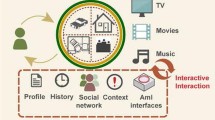Abstract
In the age of ambient media, people are surrounded by lots of physical objects (media objects) for rendering the digital world in the natural environment. These media objects should interact with users in a way that is not disturbing for them. To address this issue, this work presents a design and automation strategy for augmenting the world around us with personalized ambient media services that behave in a considerate manner. That is, ambient services are capable of adjusting its obtrusiveness level (i.e., the extent to which each service intrudes the user’s mind) by using the appropriate media objects for each user’s situation.









Similar content being viewed by others
Notes
A video of the software infrastructure in execution is provided in http://www.pros.upv.es/routines.
Screenshots in http://www.pros.upv.es/routines.
References
Bencomo N, Grace P, Flores-Cortés CA, Hughes D, Blair GS (2008) Genie: supporting the model driven development of reflective, component-based adaptive systems. In: ICSE, pp 811–814
Blumendorf M, Lehmann G, Albayrak S (2010) Bridging models and systems at runtime to build adaptive user interfaces. In: Proc. of EICS 2010. ACM, pp 9–18
Brown DM (2010) Communicating design: developing web site documentation for design and planning, 2nd edn. New Riders Press
Calinescu R (2011) When the requirements for adaptation and high integrity meet. In: Proceedings of the 8th workshop on assurances for self-adaptive systems, ASAS ’11. ACM, New York, pp 1–4
Filieri A, Ghezzi C, Tamburrelli G (2011) Run-time efficient probabilistic model checking. In: Proceedings of the 33rd International Conference on Software Engineering, ICSE ’11. ACM, New York, pp 341–350
Gershenfeld N, Krikorian R, Cohen D (2004) The internet of things. Sci Am 291(4):46–51
Gibbs WW (2005) Considerate computing. Sci Am 292(1):54–61
Gulliksen J, Goransson B, Boivie I, Blomkvist S, Persson J, Cajander A (2003) Key principles for user-centred systems design. Behav Inform Technol 22:397–409
Hinckley K, Horvitz E (2001) Toward more sensitive mobile phones. In: Proc. of the UIST ’01, pp 191–192
Ho J, Intille SS (2005) Using context-aware computing to reduce the perceived burden of interruptions from mobile devices. In: Proc. of CHI ’05. ACM, pp 909–918
Horvitz E, Kadie C, Paek T, Hovel D (2003) Models of attention in computing and communication: from principles to applications. Commun ACM 46:52–59
Ju W, Leifer L (2008) The design of implicit interactions: making interactive systems less obnoxious. Des Issues 24(3):72–84
Kortuem G, Kawsar F, Fitton D, Sundramoorthy V (2010) Smart objects as building blocks for the internet of things. IEEE Internet Comput 14(1):44–51
Lewis JR (1995) Ibm computer usability satisfaction questionnaires: psychometric evaluation and instructions for use. Int J Hum Comput Interact 7(1):57–78
Lugmayr A, Risse T, Stockleben B, Laurila K, Kaario J (2009) Semantic ambient media—an introduction. Multimed Tools Appl 43(3):337–359
Mattern F (2003) From smart devices to smart everyday objects. In: Proc. Smart Objects Conf. (SOC 03). Springer, pp 15–16
Morin B, Barais O, Jezequel JM, Fleurey F, Solberg A (2009) Models run.time to support dynamic adaptation. Comput 42(10):44–51
Nelson L, Churchill EF (2005) User experience of physical-digital object systems: implications for representation and infrastructure. Paper presented at smart object systems workshop, in cojunction with ubicomp 2005
Paternò F (2002) Concurtasktrees: an engineered approach to model-based design of interactive systems. In: L.E. Associates (ed) The handbook of analysis for human-computer interaction, pp 483–500
Paternò F (2003) From model-based to natural development. HCI International, pp 592–596
Ramchurn SD, Deitch B, Thompson MK, Roure DCD, Jennings NR, Luck M (2004) Minimising intrusiveness in pervasive computing environments using multi-agent negotiation. MobiQuitous ’04, pp 364–372
Runeson P, Höst M (2009) Guidelines for conducting and reporting case study research in software engineering. Empir Softw Eng 14(2):131–164
Schmidt A (2000) Implicit human computer interaction through context. Pers Technol 4(2–3):191–199
Serral E, Valderas P, Pelechano V (2010) Supporting runtime system evolution to adapt to user behaviour. In: Proc. of CAiSE’10, pp 378–392
Serral E, Valderas P, Pelechano V (2010) Towards the model driven development of context-aware pervasive systems. PMC 6(2):254–280
Siegemund F (2004) A context-aware communication platform for smart objects. In: Proc of the int conf on pervasive computing. Springer, pp 69–86
Streitz NA, Rocker C, Prante T, Alphen Dv, Stenzel R, Magerkurth C (2005) Designing smart artifacts for smart environments. Comput 38(3):41–49. doi:10.1109/MC.2005.92
Thiesse F, Kohler M (2008) An analysis of usage-based pricing policies for smart products. Electron Mark 18(3):232–241. doi:10.1080/10196780802265751
Vastenburg MH, Keyson DV, de Ridder H (2008) Considerate home notification systems: a field study of acceptability of notifications in the home. Pers Ubiquit Comput 12(8):555–566
Acknowledgements
This work has been developed with the support ofMICINN, under the project EVERYWARE TIN2010-18011, and the support of the Christian Doppler Forschungsgesellschaft and the BMWFJ, Austria.
Author information
Authors and Affiliations
Corresponding author
Rights and permissions
About this article
Cite this article
Serral, E., Gil, M., Valderas, P. et al. Automating unobtrusive personalized services in ambient media environments. Multimed Tools Appl 71, 159–178 (2014). https://doi.org/10.1007/s11042-013-1634-2
Published:
Issue Date:
DOI: https://doi.org/10.1007/s11042-013-1634-2




